

Sound Waves and Music. Restoration of the Missing Fundamental. Acoustic/auditory phenomenon – music, mind and spirit by Tim McKamey I ran across this in Daniel J.
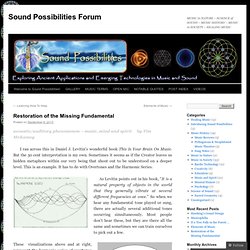
Levitin’s wonderful book This Is Your Brain On Music. But the 50 cent interpretation is my own. Sometimes it seems as if the Creator leaves us hidden metaphors within our very being that shout out to be understood on a deeper level. This is an example. As Levitin points out in his book, “It is a natural property of objects in the world that they generally vibrate at several different frequencies at once.” These visualizations above and at right, represent the harmonic series of overtones that occur whenever a single fundamental tone is sounded. Category:Tuvan musical instruments. Online Audio Converter (MP3, WAV, Ogg, WMA, M4A, AAC) – media.io. What to say when you’re asked to work for free. If you own a small business or are self-employed, sooner or later you will be asked to work for free.

The more successful you become, the more requests you’ll get. But with the right response, you can turn these freeloaders into something positive. You may want or need to work for free, especially when you’re just starting out to build a resume, client list or broaden your skills. At any time, you may be happy to donate your time and talent to good causes or very good friends. Here are some ways to respond to common requests: I can’t pay you, but you’ll get great exposure What exactly is the nature of the exposure? I don’t have a budget for this project When does your next fiscal year start? We’re a start-up and don’t have any money I’m swamped right now. There are lots of other people who will do it for free. You should absolutely contact one of them. Tuvan throat singing. The Alash Ensemble Khoomei, Hooliin Chor (in Mongolian, ‘throat harmony’), or Mongolian throat singing is one particular variant of overtone singing practiced by the Mongol people in Mongolia, Inner Mongolia, and Tuva.
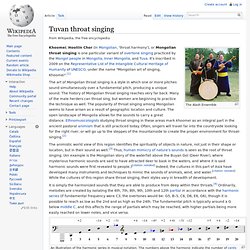
It's inscribed in 2009 on the Representative List of the Intangible Cultural Heritage of Humanity of UNESCO, under the name "Mongolian art of singing, Khoomei".[1] The art of Mongolian throat singing is a style in which one or more pitches sound simultaneously over a fundamental pitch, producing a unique sound. The history of Mongolian throat singing reaches very far back.
Many of the male herders can throat sing, but women are beginning to practice the technique as well. The Syntonic Comma. The free dictionary.
Articles and Publications. Tools. Www.plainsound.org/pdfs/JC&ToH.pdf. Harmonic series (music) Harmonic series of a string with terms written as reciprocals (2/1 written as 1/2).

A harmonic series is the sequence of all multiples of a base frequency. Any complex tone "can be described as a combination of many simple periodic waves (i.e., sine waves) or partials, each with its own frequency of vibration, amplitude, and phase. "[1] (Fourier analysis) Mystic chord. Mystic chord on C.

Play . It consists of the pitch classes: C, F♯, B♭, E, A, D. This is often interpreted as a quartal hexachord consisting of an augmented fourth, diminished fourth, augmented fourth, and two perfect fourths. However, the chord may be spelled in a variety of ways, and it is related to other pitch collections, such as being a hexatonic subset of the Overtone scale, lacking the perfect fifth. Nomenclature[edit] The term "mystic chord", appears to derive from Scriabin's intense interest in Theosophy, and the chord is imagined to reflect this mysticism. It is also known as the "Prometheus chord", after its extensive use in his work Prometheus: The Poem of Fire, Op.60. Scriabin himself called it the "chord of the pleroma" (aккорд плеромы - akkord pleromy),[1] which "was designed to afford instant apprehension of -that is, to reveal- what was in essence beyond the mind of man to conceptualize.
Qualities[edit] Synthetic chord's dominant quality[3] Use by Scriabin[edit] Synthetic chord. However, synthetic chords originated not with Roslavets but with musicologist Sabaneev and his study of composer Scriabin's Prometheus published in 1910.[3][4] See: Mystic chord.
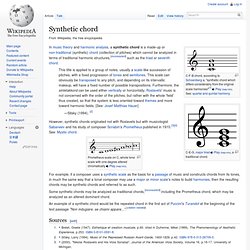
Whole tone scale. Augmented triad on C Play .
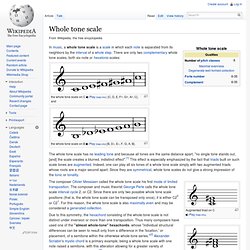
Augmented triad on D Play . The composer Olivier Messiaen called the whole tone scale his first mode of limited transposition. The composer and music theorist George Perle calls the whole tone scale interval cycle 2, or C2. Due to this symmetry, the hexachord consisting of the whole-tone scale is not distinct under inversion or more than one transposition. Augmented sixth chord. The interval of an augmented sixth normally resolves outwards by semitone to an octave.
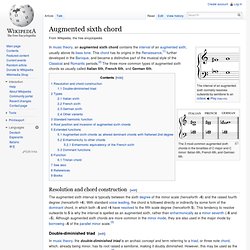
Play The 3 most common augmented sixth chords in the tonalities of C major and C minor: Italian 6th, French 6th, and German 6th. Resolution and chord construction[edit] Double-diminished triad[edit]